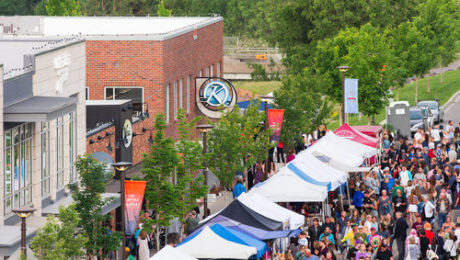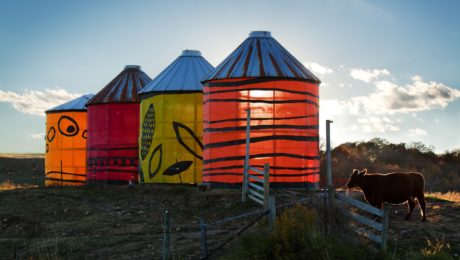Brian Williams shares some great thoughts on local food systems and why they are important for building strong communities in his August 2017 article, Local Food: Turning your Greens into Greenbacks.
“There are many reasons to promote local food in your community: freshness; knowing where your food came from and how it was grown; supporting local farmers; having an alternative to fruits and vegetables that were trucked across the country from California or Florida.
But one of the best reasons is economic development: keeping your food dollars in your own town, county, and state.“
—Brian Williams, consultant for Local Nexus LLC

Fresh bagels at Silver Valley Community Market
According to the USDA, more than 150,000 farmers, ranchers, and agricultural entrepreneurs are selling quality products directly to consumers nationwide. These direct sales at farmers markets exceeded $1.5 billion nationwide in 2015.
“As the number of markets grow around the country, so do the number of farmers. This means that with the help of farmers markets, hundreds of farmers choose to stay in agriculture over another profession, thereby helping to preserve our farmland and rural traditions.”
Farmers markets also act as an important “third place” or gathering space in your community. These places can cultivate a different kind of connection among people in our communities, welcoming people and providing space for neighbors and friends to meet one another.
As of today, there are over 8,000 markets listed in the National Farmers Market Directory, demonstrating the continued demand for community-oriented markets and the many contributions they make to local economies. Connecting rural to urban, farmer to consumer, and fresh ingredients to our diets, farmers markets are becoming economic and community centerpieces in cities and towns across the U.S. The Inland Northwest is no exception:
IDAHO FARMERS MARKETS:
Athol: Athol Farmers Market
Bonners Ferry: Bonners Ferry Farmers Market
Coeur d’Alene: Wednesday Market
Harrison: Harrison Grange Market
Hayden: Saturday Market
Kellogg: Silver Valley Community Market
Moscow: Moscow Farmers Market, Tuesday Community Market
Sandpoint: Farmers’ Market at Sandpoint
WASHINGTON FARMERS MARKETS:
Chewelah: Chewelah Farmers Market
Colville: NEW Farmers Market
Clayton: Clayton Farmers Market
Kettle Falls: Kettle Falls Farmers Market
Liberty Lake: Liberty Lake Farmers’ Market
Newport: Newport Farmers Market
Pullman: Pullman Farmers Market
Othello: Othello Farmers Market
Spokane: Emerson-Garfield Farmers’ Market, Fairwood Farmers Market, Kendall Yards Night Market, Millwood Farmers’ Market, Perry Street Thursday Market, Spokane Farmers’ Market, and West Plains Farmers’ Market
Spokane Valley: Spokane Valley Farmers Market
The national coworking culture is now fifteen years old. Successful coworking spaces know they need to be more than just secure wifi, free coffee and meeting rooms.
“Coworking spaces have to go above and beyond to stay competitive and thrive—developing niches spaces for certain businesses (legal, fashion and beauty, blockchain, film production), offering unique experiences such as coliving or childcare, plus getting creative by opening spaces in underutilized real estate like hotel business centers or within stores.”
—Madison Maidment, COO of Coworker

Members of MosCoWork in Moscow, Idaho, have the option of renting dedicated desks or part time subscriptions.
One novel idea is an app that connects you with another local option: your neighbor’s living room. Codi, a new startup launching soon in the Bay Area of California, turns apartments and houses into temporary, affordable coworking spaces during the day.
“I used to work from home, and it’s very isolating. When you go to coffee shops, they can be very distracting. And there were no working options close by, and downtown coworking spaces are very expensive.”
—Christelle Rohaut, CEO/founder of Codi
LiquidSpace is a national online network that connects people with spaces. Users can search for meeting rooms, coworking space, private office suites, brainstorming-ready spaces, event spaces, and, dedicated desks. Searches can be customized to neighborhoods or specific properties to be the first to know of new space availability.
The list of coworking spaces in the Inland Northwest continues to grow, as rural communities recognize the need to attract flexible workforce and encourage a startup culture.
IDAHO CO-WORKING SPACES:
Bonners Ferry: The Plaza Downtown
Coeur d’Alene: The Innovation Den, SpaceShare CDA, Rockford Building
Hayden: Panhandle Area Council Business Incubator
Moscow: MosCoWork
Sandpoint: The Office Sandpoint
WASHINGTON CO-WORKING SPACES:
Liberty Lake: Liberty Lake Portal
Pullman: Crimson Commerce Club (C3)
Harrington: The Post & Office
Spokane: Niche Coworking, Fellow Coworking, Level Up, Regus, and StartUp Spokane
Washington State grant helps international food processor expand, add jobs in Othello
April 15, 2019
OLYMPIA, WA – The Washington Department of Commerce provided a $100,000 grant to the Adams County Development Council from Gov. Inslee’s Economic Development Strategic Reserve Fund to support the expansion of SVZ-USA Washington Inc., the only North American subsidiary of Netherlands-based specialty food processor SVZ International B.V.
The company plans to invest $4.8 million to increase capacity at its Othello facility opened in 2000, adding 17 new manufacturing jobs to its 90 existing employees.
“SVZ is an important part of the food processing cluster in Othello, and we are pleased to help Adams County Development Council partner with the company to make infrastructure improvements that will strengthen the entire community and prepare for future growth,” said Commerce Director Lisa Brown.
“We are excited to have SVZ-USA moving forward with a $4.8 million expansion project that will bring new jobs to the city of Othello and Adams County,” said Adams County Economic Development Director Stephen McFadden.
The grant will help offset the cost of sewer system improvements required by the city of Othello for the expansion. This will also extend the new sewer line well beyond SVZ’s building, facilitating future municipal connections and growth.
SVZ-USA specializes in processing fruit and vegetable juices, concentrates and purees for food and beverage manufacturers around the world. The company is recognized globally for sustainability and agronomy management best practices.
“The company is actively involved in our community in multiple ways,” McFadden added. “SVZ employees volunteer with several community organizations, and the company plays an active role in the Othello Career Showcase where we connect students in grades 8 through 12 with local employers to introduce them to the numerous career paths that exist within their hometown.”
“Building and growing a great business requires equally great relationships. We are very pleased with the relationship we have with The State of Washington, Adams County, and the City of Othello. The grant funding provided facilitates our expansion, and confirms the business friendly and supportive role of government to our international leadership,” said David E. Stewart, president, SVZ-USA Washington.
“In addition to direct employment increases, as our sourcing of raw materials is predominantly local, we look forward to expanding our local sourcing as we partner with farmers for our agro supply needs, increasing by about 30 million pounds with this expansion,’ he added. “Our business success requires long-term relationships with customers, farmers, employees, and the communities in which we operate.”
first posted in the National Governor’s Association via Medium, March 8, 2019.
The Creative Sector: A Proven Economic Catalyst for Rural America
Rural regions contain some of our nation’s most iconic landscapes and cherished heritage, yet many of them are struggling with persistent economic obstacles. Rural America is contending with the outmigration of young and skilled workers, low levels of educational attainment, infrastructure needs (both physical and digital), rising poverty rates, barriers to health care and poor health outcomes and problems related to an evolving economy ― especially the loss of industry.
While the overall U.S. economy has rebounded from the most recent recession, rural areas have not shared equally in the gains. In spite of facing similar problems, some rural areas have prospered since the Great Recession: They experienced population growth, earnings growth, higher household incomes and the ability to attract and retain workers.
The “secret sauce” for those prospering rural areas is their ability to leverage their creative sector assets to catalyze economic and workforce development initiatives in those rural areas. An extensive body of research by economists at the U.S. Department of Agriculture and the National Endowment for the Arts has found:
- Rural counties that are home to performing arts organizations experienced population growth three times faster and higher household incomes (up to $6,000 higher) than rural counties lacking performing arts organizations.
- Rural counties with design-driven businesses ― those that integrate branding and design services ― recovered more quickly from the recession, showing more growth in weekly earnings over the period from 2010 to 2014.
- Two out of three rural businesses report that arts and entertainment are important to attracting and retaining workers.
- A forthcoming action guide from the National Governors Association (NGA), in partnership with the National Endowment for the Arts (NEA) and the National Assembly of State Arts Agencies (NASAA), describes three principles of arts-based rural development for governors and other state policymakers.
- Creative sector initiatives are most effective when attuned to the particular creative assets and needs of rural communities.
- Those creative and cultural assets can be used as a springboard for local economic development ― that is, they can catalyze growth and amplify broader community planning and rural Main Street development.
- Creative sector initiatives add value when integrated with economic development, workforce development, community development and other state and local policies and practices.
When these principles are applied within a state’s existing policy framework, the steps can lift employment, wages and the quality of place in rural areas.
The action guide features numerous successful high-profile examples of states, regions and rural communities that have become more economically resilient and sustainable through creative sector initiatives. The Montana Artrepreneur Program, for example, expands entrepreneurial opportunities for rural visual artists by providing personal coaching and other business and marketing training over 10 months. Artists who received certification through the program between 2009 and 2014 experienced, on average, a 650 percent net sales increase and an 87 percent increase in out-of-state sales.
Nebraska Gov. Pete Ricketts is promoting creative entrepreneurship by providing access to “maker” equipment, such as 3D printers, through rural libraries. This is intended to help strengthen the maker culture in rural areas and expand the libraries’ roles as anchor organizations for economic development. The libraries are supported by community action teams who are reaching out to residents and offering training.
States can similarly encourage rural community colleges to serve as anchors for creativity-based economic growth. Sheridan, a city in rural northern Wyoming, has been beefing up its creative economic development for more than a decade. It started by collaborating with the Northern Wyoming Community College District to commission a cultural sector inventory and form a local Creative Economies Council. The Wyoming Arts Council funded the community college district’s theater and dance program organizations, which gradually became prominent parts of the local asset portfolio. The state also contributed to funding the redevelopment of a Performing Arts and Education Center affiliated with the local college ― all to the benefit of the surrounding rural region.
Every state has rural areas, including some that we don’t normally think about as being rural, such as New York and Maryland. In New York, interagency coordination has been the key to providing grants focusing on workforce development incorporating the arts. The state’s Regional Economic Councils (REDCs), through the New York State Council on the Arts, are providing $5 million to support projects using the arts to foster workforce readiness and development. Local organizations can apply to develop career-training programs in artistic fields, including internships and apprenticeships in collaboration with high schools, community colleges and four-year colleges. Also, grants for large capital improvement projects through the Arts and Culture Facilities Improvement Grant Program are similarly being offered through the REDCs. The projects are intended to promote accessibility, stability and sustainability of cultural arts facilities and strengthen tourism and business development statewide ― “including in rural communities where such investments can be particularly impactful.” In 2018, the program awarded $20 million for capital improvement projects, and another $10 million is planned in 2019.
Further, some states have designated or certified creative districts that support workforce development. For example, in 2016, Maryland’s 24 state-designated Arts and Entertainment Districts supported more than 8,500 jobs, which collectively yielded $267 million in wages, $63.2 million in local and state tax revenue and almost $856 million in state economic output. Today, Maryland has 26 such districts.
The Next Generation Initiative headquartered in rural Iowa is a collaboration between the Art of the Rural and the Rural Policy Research Institute at the University of Iowa to strengthen connections among the arts, public policy and community and economic development. The Initiative’s web-based Digital Learning Commons and Exchange features how-to material on rural “creative placemaking” which occurs when arts organizations and community development practitioners deliberately integrate the arts and culture into community revitalization work and engage partners from a range of sectors, such as agriculture and food, and policy areas such as economic development, community development, housing and workforce development.
NGA’s forthcoming action guide, Rural Prosperity through the Arts and Creative Sector: A Rural Action Guide for Governors and States, outlines principles, process steps and further examples that constitute an overall Systems Change Framework for rural America based on the creative sector. The Systems Change Framework is organized according to five key roles for governors and states: providing leadership; capitalizing on cultural assets; building the state’s infrastructure for creative partnerships with other policy areas; developing local talent with creative skills and creating an environment friendly to investment and innovation. The guide will be released March 12, 2019. Follow the conversation on Twitter with the hashtag #ruralarts.



